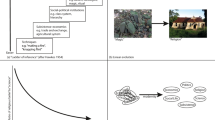Abstract
As three of the articles in this collection demonstrate, one central axis of the Zionist archaeological project is the absolute necessity of diminishing, and ultimately erasing, the importance and existence of aspects of “the archaeological record” that pertain to non-Jewish presences in Palestine, particularly and especially Islamic civilizations and the long-term presence of an indigenous non-Jewish Palestinian population. In this introduction, I focus, however, upon Zionist archaeology’s rearticulation of Jewish identity in nationalist form, an operation that has entailed the elaboration of a consistently simplified, unidimensional, or narrowly channeled interpretive version of Jewish history and Jewish identity in Palestine over time. Through several pointed queries, I suggest alternative interpretations of one element of the Zionist archaeological narrative that in turn could lead to other ways of thinking about the long-term presence of Jewish people in Palestine.
Résumé
Comme le démontrent trois des articles de cette collection, l’un des axes principaux du projet archéologique sioniste réside dans l’absolue nécessité de réduire, et finalement d’effacer, l’importance et l’existence des aspects de « l’empreinte archéologique » qui ont trait aux présences non-juives en Palestine. Sont tout particulièrement et spécialement concernées les civilisations islamiques et la présence à long terme de populations indigènes palestiniennes non-juives. Dans cette introduction, je mets cependant l’accent sur la ré-articulation de l’identité juive par l’archéologie sioniste autour d’une forme nationaliste ; une opération qui a exigé l’élaboration au fil du temps d’une version issue d’une interprétation systématiquement simplifiée, unidimensionnelle ou très orientée de l’histoire juive et de l’identité juive en Palestine. Au travers de plusieurs questions très critiques, je suggère des interprétations alternatives à un élément du récit archéologique sioniste, qui pourraient conduire à d’autres façons de penser la présence à long terme des Juifs en Palestine.
Resumen
Como demuestran tres de los artículos en esta recopilación, un eje central del proyecto arqueológico sionista es la absoluta necesidad de disminuir, y en última instancia borrar, la importancia y existencia de aspectos del "registro arqueológico" que pertenecen a presencias no judías en Palestina, en particular y especialmente civilizaciones islámicas y la presencia a largo plazo de poblaciones indígenas palestinas no judías. En esta introducción, me centro, sin embargo, en la rearticulación por parte de la arqueología sionista de la identidad judía en forma nacionalista, una operación que ha conllevado la elaboración de una versión interpretativa, constantemente simplificada, unidimensional o canalizada con estrechez, de la historia judía y de la identidad judía en Palestina a lo largo del tiempo. Mediante varias preguntas intencionadas, sugiero interpretaciones alternativas de un elemento de la narrativa arqueológica sionista que a su vez podría llevar a otras formas de pensar sobre la presencia a largo plazo de los judíos en Palestina.
Similar content being viewed by others
References
Abu El-Haj, Nadia (2001) Facts on the Ground: Archaeological Practice and Territorial Self-Fashioning in Israeli Society, University of Chicago PressChicago.,
Anderson, Benedict (1991) Imagined Communities: Reflections on the Origin and Spread of Nationalism, VersoLondon.,
Backmann, René (2010) A Wall in Palestine, PicadorLondon.,
Baumgarten, Joseph M. (1999) Art in the Synagogue: Some Talmudic Views. In Jews, Christians and Polytheists in the Ancient Synagogue: Cultural Interaction During the Greco-Roman Periodpp. 71–85, edited by Steven Fine, RoutledgeLondon.,
Benvenisti, Meron (2000) Sacred Landscape: The Buried History of the Holy Land Since 1948, University of California PressBerkeley.,
Chatterjee, Partha (1986) Nationalist Thought and the Colonial World, University of Minnesota PressMinneapolis.,
Chatterjee, Partha (1993) The Nation and Its Fragments: Colonial and Postcolonial Histories, Princeton University PressPrinceton.,
Colwell-Chanthaphonh, Chip, Ferguson, T. J. (eds.) (2008) Collaboration in Archaeological Practice: Engaging Descendant Communities, Rowman and Littlefield PublishersLanham, MD.,
De Cesari, Chiara 2010. Creative Heritage: Palestinian Heritage NGOs and Defiant Acts of Government. American Anthropologist 112(4):625–637.
Field, Les W. 2013. Mapping Erasure: The Power of Nominative Cartography in the Past and Present of the Muwekma Ohlone of the San Francisco Bay Area. In Recognition, Sovereignty Struggles and Indigenous Rights in the United States: A Sourcebook, edited by Amy E. Den Ouden and Jean O’Brien, pp. 287–310. University of North Carolina Press.
Fine, Steven (2005) Art and Judaism in the Greco-Roman World: Toward a New Jewish Archaeology, Cambridge University PressCambridge.,
Fox, Richard (ed.). 1990. Nationalist Ideologies and the Production of National Cultures. American Ethnological Society Monograph Series, Number 2.
Gellner, Ernest (1983) Nations and Nationalism, Basil BlackwellOxford.,
Gnecco, Cristóbal, Ayala, Patricia (eds.) (2011) Indigenous Peoples and Archaeology in Latin America, Left Coast PressWalnut Creek, CA.,
Halsberghe, Gaston H. (1972) The Cult of Sol Invictus, E.J. BrillLeiden.,
Israel Nature and Parks Authority Nd. Zippori National Park, Pamphlet.
Jensen, Robin M. (2005) The Dura Europos Synagogue, Early Christina Art, and Religious Life in Dura Europos. In Jews, Christians and Polytheists in the Ancient Synagogue: Cultural Interaction During the Greco-Roman Periodpp. 174–190, edited by Steven Fine, RoutledgeLondon.,
Khalidi, Walid 1992. All That Remains: The Palestinian Villages Occupied and Depopulated by Israel in 1948. Washington DC: Institute for Palestine Studies (reprint 2006).
Liebmann, Matthew, Rizvi, Uzma Z. (eds.) (2008) Archaeology and the Postcolonial Critique, Altamira PressWalnut Creek, CA.,
Magness, Jodi 2005. Heaven on Earth: Helios and the Zodiac Cycle in Ancient Palestinian Synagogues. Dumbarton Oaks Papers 59(2005):1–52.
Makdisi, Saree (2008) Palestine Inside Out: An Everyday Occupation, WW Norton and Co.New York.,
Murdoch, Adrian (2008) The Last Pagan: Julian the Apostate and the Death of the Ancient World, StroudGloucestershire.,
Reiner, Elchanan and David Amit 2012. “Samson Follows the Sun to Galilee,” Ha’aretz.com, October 6.
Smith, Rowland (1995) Julian’s Gods: Religion and Philosophy in the Thought and Action of Julian the Apostate, RoutledgeLondon.,
Swidler, Nina, Dongoske, Kurt E., Anyon, Roger, Downer, Alan S. (eds.) (1997) Native Americans and Archaeologists: Stepping Stones to Common Ground, Altamira PressWalnut Creek, CA.,
Watkins, Joe (2000) Indigenous Archaeology: American Indian Values and Scientific Practices, Altamira PressWalnut Creek, CA.,
Wolfe, Patrick 2006. Settler Colonialism and the Elimination of the Native. Journal of Genocide Research 8(4):387–409.
Author information
Authors and Affiliations
Corresponding author
Rights and permissions
About this article
Cite this article
Field, L. Imagining Palestinian Archaeologies: A Sampler. Arch 9, 281–294 (2013). https://doi.org/10.1007/s11759-013-9237-0
Published:
Issue Date:
DOI: https://doi.org/10.1007/s11759-013-9237-0




